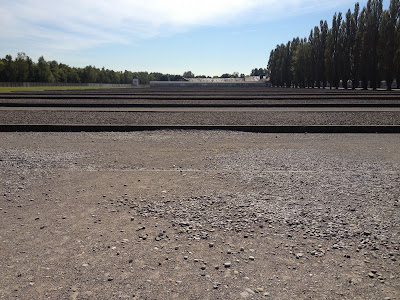Dachau & Munich, Germany
September 19-21, 2012
 |
| Ali and I cooking family dinner |
On Friday morning, we took taxis to Dachau concentration
camp. The experience was a necessary step in our pilgrimage through Europe to
not just find the best nightlife, but to cultivate ourselves as the world’s
young generation. This camp was the first of hundreds to be built under
Hitler’s reign during World War II; as the first camp, it was used as a model
for the camps to later come. It opened its gates on March 22, 1933—only 51 days
after Hitler assumed power. We each bought an audio tour with hundreds of
historical facts, testimonials, and examples recorded at our disposal and to go
along with each part of the camp. I am so happy that we did an audio tour
rather than a guided tour; the experience was much more powerful for me as I
walked around for the majority of three hours on my own. The gates which
prisoners first walked into upon their arrival read, “Arbeit macht frei,” which means, “Work makes you free.”
This personifies the image that Nazis used to describe concentration camp to
the public.
The most powerful part of the camp was the memorial. At the back of
the camp, there was a bridge over stream which is where the gas houses were
built, but never used for mass execution. Over the bridge, the density of
people increased though the volume of noise refused to heighten. The memorial
lies at the center of a U-shaped path. Despite the numerous people at the camp,
I walked the duration of the pathway covered in trees in solidarity. This
experience echoed what I imagined the prisoners of the camp to feel every day:
though surrounded by thousands grieving, the prisoners and I each remained
alone in a quiet journey of hope and sorrow. In this time period, an
approximated 35,000 to 43,000 prisoners died as slaves in the Dachau
concentration camp. A memorial in the center of the camp reads, “May the
example of those who were exterminated here between 1933 and 1945 because they
resisted Nazism help to unite the living for the Defense of peace and freedom
in respect for their fellow men." Since the restoration of the camp,
religious memorials and chapels have been built to honor and pray for those who
lost their lives and so that another massacre such as the Holocaust never
sweeps the world again. These sites were the Russian Orthodox Chapel, the
Mortal Suffrage of Christ Monument, the Jewish Memorial, the Church and Convent
of the Carmelite Nuns, and the Church of Reconciliation.
 |
| Where barracks used to stand at Dachau concentration camp |
Marienplatz, Munich’s main
square caught me by surprised as an escalator up from the metro station plopped
me into the middle of the city. This main square, filled with ornate clock
towers and detailed architecture has existed as the city center since 1158. As
Holland characterized it, “I felt like I was in New York for New Year's Eve.”
The square was buzzing with people visiting the city for Oktoberfest. Drindels
and steins lined shop windows and members of our group picked up souvenirs to
adorn themselves in for the festivities to commence tomorrow. We walked the
streets of Munich and I enjoyed strolling through the city and making my own
memories rather than coming into the plaza with preconceived visions of what it
would look like.
Oktoberfest
Oktoberfest 2012: not a festival, but a marathon. And how
does one prepare for a marathon? Energy, strategy, and stamina. After seven
days of traveling, spirits were high as we got into our beds early Friday night.
We enjoyed another family dinner but instead of locking ourselves in a kitchen
afterwards, we took turns listening to the most valuable voice memo Matt has
taken on his phone to date. While the rest of us went to Dachau earlier that
day, Matt and Alex explored Munich. Continuing our ever present theme of
unfathomable fate unfolding in our favor, Matt recognized a tour guide he had
when he came to Europe with his baseball team a few years before. They sat and
had a long conversation; thirty minutes of this was dedicated to the strategy
of Oktoberfest. Since we were going on opening day -- for all intents and
purposes of this marathon the tour guide will take on the title of "our
coach" -- told us we should get to the tent we chose to go to by 7:00. A
man of Oktoberfest’s, he said of all his visits, the best tent to go to is
Augustiner. By his claim, this was the tent that if ten years down the road, I
was to meet a Bavarian and tell them I went to Oktoberfest, they would applaud
my trip. Of the fourteen tents, some considered notorious "tourist"
tents would dismay locals, but Augustiner was no tourist tent. A tent filled
with locals, Augustiner sounded like the perfect tent for us. Our coach
continued by telling us that the Lederhosen that we had seen selling for
obscene prices throughout the city were unnecessary for our full enjoyment of
the festivities, though everyone would be wearing them. He also told us
to make sure to tip our waiters well in order to gain there unfailing and
speedy service. While the preceding was the most useful advice, the advice to
bring as much food as we could to eat while we would stand in line outside the
tent provided the most entertainment. We took these words to heart and with
limited resources, we cooked a heaping trash bag full of pasta that we put in a
big cereal box: our carb-loading, pregame pasta. A few minutes before 9:00,
Holland said the pregame, beer, prayer.
 |
| Opening day in the Augustiner-Festhalle tent |
 |
| Got a table! |
 |
| Oktoberfest 2012 |




No comments:
Post a Comment